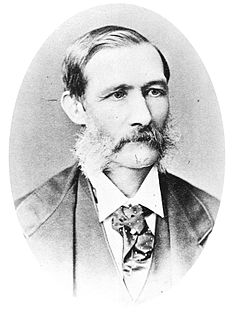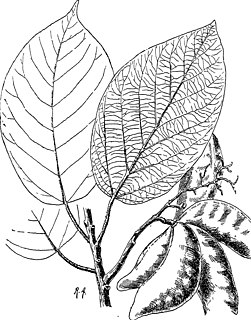Related Research Articles

Joachim von Ribbentrop was a German politician who served as Minister of Foreign Affairs of Nazi Germany from 1938 to 1945.
The conservation movement, also known as nature conservation, is a political, environmental, and social movement that seeks to manage and protect natural resources, including animal, fungus, and plant species as well as their habitat for the future. Conservationists are concerned with leaving the environment in a better state than the condition they found it in. Evidence-based conservation seeks to use high quality scientific evidence to make conservation efforts more effective.

Sir Dietrich Brandis was a German-British botanist and forestry academic and administrator, who worked with the British Imperial Forestry Service in colonial India for nearly 30 years. He joined the British civil service in Burma in 1856, shortly afterwards became head of the British forestry administration in all of Burma, and served as Inspector General of Forests in India from 1864 to 1883. He returned to Europe in 1883, dividing his time between Bonn and Greater London. In retirement he dedicated himself to scholarly work, resulting in the book Indian Trees (1906), his magnum opus. Brandis is considered the father of tropical forestry and has also been described as the father of scientific forestry. In addition to his work in India, he also had a significant influence on forest management in the United States.
The All India Services (AIS) comprises three civil services: the Indian Administrative Service, the Indian Police Service and the Indian Forest Service. A unique feature of the All India Services is that the members of these services are recruited by the centre, but their services are placed under various State cadres, and they have the liability to serve both under the State and under the centre. Due to the federal polity of the country, this is considered one of the tools that makes union government stronger than state governments. Officers of these three services comply to the All India Services Rules relating to pay, conduct, leave, various allowances etc.

The Indian Forest Service is one of the three elite All India Services of the Government of India and is one of the central natural resource services. The other two civil service being the Indian Administrative Service and the Indian Police Service. It was constituted in the year 1966 under the All India Services Act, 1951, by the Government of India.
Hari Singh (1910–2003) was the Inspector General of Forests of India in the 1960s. Shri Hari Singh came from a find tradition of great Indian Foresters. Among several other awards, he was awarded the Member of the Order of the British Empire (MBE), a distinguishing honor bestowed upon him by the British Government. He held India's highest office of forest administration, namely, Inspector General of Forests, from 1964 to 1969, and graced innumberable national and international bodies on the development of the forestry sector.

The Indian Forest Act, 1927 was largely based on previous Indian Forest Acts implemented under the British. The most famous one was the Indian Forest Act of 1878. Both the 1878 act and the 1927 act sought to consolidate and reserve the areas having forest cover, or significant wildlife, to regulate movement and transit of forest produce, and duty leviable on timber and other forest produce. It also defines the procedure to be followed for declaring an area to be a Reserved Forest, a Protected Forest or a Village Forest. It defines what is a forest offence, what are the acts prohibited inside a Reserved Forest, and penalties leviable on violation of the provisions of the Act.

The Changa Manga is a planted forest which includes a wildlife preserve, in the Kasur and Lahore districts of Punjab, Pakistan. It is located approximately 80 kilometers south-west of Lahore. It was once the largest man-made forest in the world but has undergone illegal deforestation at a massive scale in recent times.
Carl Alwin Schenck was a pioneering forestry educator in North America, known for his contributions as the forester for George W. Vanderbilt's Biltmore Estate, and the founder of the Biltmore Forest School, the first practical forestry school in the United States, in 1898, near Brevard, NC.

Hugh Francis Clarke Cleghorn of Stravithie MD, LLD, FRSE, FLS was a Madras-born Scottish physician, botanist, forester and land owner. Sometimes known as the father of scientific forestry in India, he was the first Conservator of Forests for the Madras Presidency, and twice acted as Inspector General of Forests for India. After a career spent in India Cleghorn returned to Scotland in 1868, where he was involved in the first ever International Forestry Exhibition, advised the India Office on the training of forest officers, and contributed to the establishment of lectureships in botany at the University of St Andrews and in forestry at the University of Edinburgh. The plant genus Cleghornia was named after him by Robert Wight.
Forest Survey of India (FSI), was founded in June 1981 and was headquartered at Dehradun in Uttarakhand, it is the Government of India Ministry of Environment, Forest and Climate Change organization which conducts forest surveys, studies and researches to periodically monitor the changing situations of land and forest resources and present the data for national planning, conservation and sustainable management of environmental protection as well for the implementation of social forestry projects.

Sir Wilhelm Philipp Daniel Schlich, also known as William Schlich, was an eminent German-born forester who worked extensively in India for the British administration. As a professor at Cooper's Hill, he influenced colonial forestry across the British colonies. His major work was a five volume Manual of Forestry (1889-96).
Robert Scott Troup CMG CIE FRS was a British forestry expert. He spent the first part of his career in Colonial India, returning to England in 1920 to head Oxford's School of Forestry.

The Madras Forest Department, now officially, Tamil Nadu Forest Department, is an government department of Tamil Nadu. The department is responsible for managing all the protected areas and forests plus environmental and wildlife related issues of Tamil Nadu state in South India. The objective of the Tamil Nadu Forest Department is to conserve biodiversity and eco-systems of forests and wilderness areas to ensure water security and food security of the state.
The New Year Honours 1890 were appointments by Queen Victoria to various orders and honours of the United Kingdom and British India.

Henning Brandis was a German physician and microbiologist. He was Professor of Medical Microbiology and Immunology and Director of the Institute for Medical Microbiology and Immunology at the University of Bonn from 1967 until his 1984 retirement. He was editor-in-chief of the journal Zeitschrift für Immunitätsforschung. He was a member of the Academy of Sciences Leopoldina and received the Officer's Cross of the Order of Merit of the Federal Republic of Germany in 1976 for services to medical microbiology.
The Brandis family is a German family, originally a patrician family from Hildesheim, and later with ties to Denmark and British India. From the 15th century family members were influential in the politics of Hildesheim and several family members served as burgomasters. Numerous family members have been noted as lawyers, physicians and academics.
Bernhard Friedrich Brandis was a German supreme court justice.

Indian Trees: An Account of Trees, Shrubs, Woody Climbers, Bamboos, and Palms Indigenous or Commonly Cultivated in the British Indian Empire is a monograph on the trees of India, written by the German–British botanist and forestry administrator Sir Dietrich Brandis and published in London in 1906 by Archibald Constable & Co.
Max Henry Ferrars was a British colonial officer, author, photographer and university lecturer, mainly active in British Burma and later, in Freiburg, Germany. He served for 25 years in the Imperial East India Forestry Service and other public offices in colonial Burma, today's Myanmar. Together with his wife Bertha, Ferrars wrote and illustrated an extensive ethnographical and photographic study of the native cultures and societies, titled Burma and published in 1900.
References
- ↑ Barton, G. A. (2004). Empire forestry and the Origins of Environmentalism. Cambridge University Press, p.33
- ↑ Berthold Ribbentrop. Forestry in British India. Governor of India, Central Printing Officer. p. 227 . Retrieved 25 January 2015.